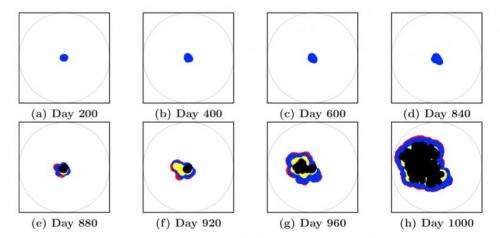Modeling tumor dormancy

Cancer constantly wages war on the human body. Battles are won, lost or sometimes end in a stalemate. In pancreatic cancer, this stalemate—known as tumor dormancy—can last up to 25 years before becoming aggressively malignant, a phenomena that is poorly understood.
A new computational model developed in the laboratory of Salvatore Torquato, a Professor of Chemistry at Princeton University, may help illuminate the conditions surrounding tumor dormancy and the switch to a malignant state. Published today in PLOS ONE, the so-called cellular automaton model simulated various scenarios of tumor growth leading to tumor suppression, dormancy or proliferation.
"The power of the model is that it lets people to test medically realistic scenarios," Torquato said. In future collaborations, these scenarios could be engineered in laboratory experiments and the observed outcomes could be used to calibrate the model.
For each scenario, a set of rules is imposed on the virtual cell population. Rules are possible interactions, such as neighboring cell death or immune system suppression, that dictate cell division through probabilities derived from past experimental data. Once the researchers programmed the rules, they watched as the simulated competition unfolded between the tumor and the environmental factors that may suppress its growth.
"We were very surprised to observe this phenomena where the tumor all of a sudden began to rapidly divide," said Duyu Chen, graduate student in the Torquato lab and lead author on the article. This was the first time that the emergent switch behavior, which has been observed clinically, occurred spontaneously in a model, Chen said.
The researchers evaluated a number of factors that could affect tumor cell growth including phenotypic changes, mechanical properties and the rate and strength of suppression factors such as the immune system. One of the model's findings was the likely suppression of tumors in harsh environments, characterized by high density and pressure.
The research team also predicted that if the number of actively dividing cells within the proliferative rim reached a certain critical level, the tumor was very likely to begin rapidly growing. This result could provide insight into early cancer treatment, Chen said.


















